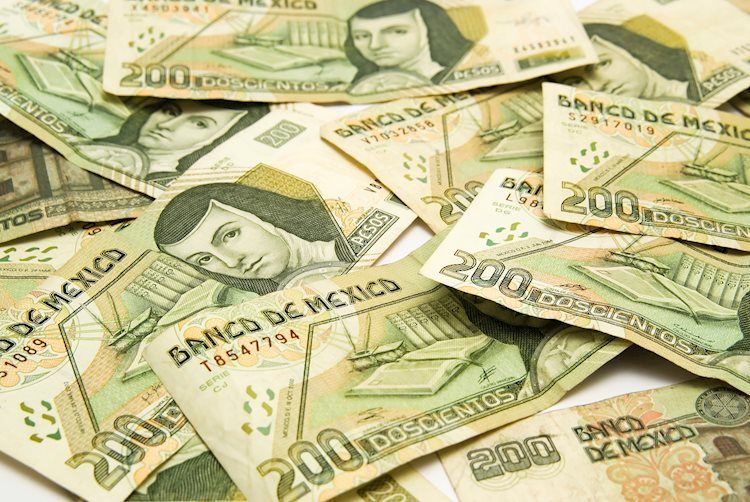- The Mexican Peso pulls back after its recent run of gains on the back of fears of global trade becoming fragmented.
- US Dollar recovers against the Peso after data shows the Fed is likely to kick the can of lowering interest rates further down the road.
- USD/MXN stalls in its short-term downtrend, but more downside is still foreseen.
The Mexican Peso (MXN) meets resistance in its upwards climb on Tuesday – and pulls back – possibly due to growing concerns about the fragmentation of international trade that could especially hit export-based emerging-market economies like Mexico.
Against the US Dollar (USD) more specifically, MXN weakens after US data showed heightened US inflation expectations, which are likely to keep interest rates in the US elevated for some time, increasing capital inflows to the Dollar.
USD/MXN is exchanging hands at 16.80, EUR/MXN at 18.12 and GBP/MXN at 21.10, at the time of publication.
Mexican Peso loses upside momentum on geopolitical concerns
The Mexican Peso lost ground on Monday after the International Monetary Fund (IMF) warned global economic growth might lose momentum due to a fragmentation of international trade along geopolitical lines.
In a speech at Stanford Institute for Economic Policy Research, IMF First Deputy Managing Director Gita Gopinath, said: “Countries are reevaluating their trading partners based on economic and national security concerns,” adding that if the trend continued, “we could see a broad retreat from global rules of engagement and, with it, a significant reversal of the gains from economic integration.”
The news comes after the US plans to impose further protectionist policies by quadrupling tariffs on Chinese electric vehicles and BRICS countries continued to erode the hegemony of the US Dollar.
At the start of May, India and Nigeria, for example, agreed to settle all their trade using their domestic currencies rather than the US Dollar. This follows similar agreements between other nations, especially China, Russia and Iran, designed to circumvent Western sanctions.
USD/MXN recovers on elevated US inflation expectations
The US Dollar gained in most pairs, including versus the Mexican Peso, after data from the Reserve Bank of New York showed a rise in inflation expectations which reinforced the inflationary outlook presented in Friday’s Michigan sentiment survey.
The NY Survey of Consumer Expectations showed consumer inflation expectations for one year ahead increased to 3.3% in April, from 3.0% in March – and the three previous months. It was the highest level since November and stands well above the Federal Reserve’s 2.0% target.
The data further reduces the chance of the Fed moving to cut interest rates in the near future, which is positive for the USD since an expectation of higher interest rates increases foreign capital inflows.
Technical Analysis: USD/MXN pulls back in a downtrend
USD/MXN – the value of one US Dollar in Mexican Pesos – has pulled back after decisively breaking below the bottom of a short-term range last week.
The breakout of the range was a decisive technical development that suggests a protracted move lower. However, after falling to a new low of 16.72 on Friday, USD/MXN reversed and started recovering.
USD/MXN 4-hour Chart
The recovery is not yet strong enough to negate the bearish implications of the breakdown from the range. The short-term trend is still probably bearish, which, given the old adage that the “trend is your friend”, suggests the odds continue favoring more downside.
The pair is still probably likely to resume its downtrend and hit the conservative target for the breakout at 16.54. This is the 0.681 Fibonacci ratio of the height of the range extrapolated lower. Further bearishness after that could reach 16.34, the full height of the range extrapolated lower.
A break below 16.72 would confirm a continuation south.
Given the medium and long-term trends are bearish, the odds further favor more downside for the pair in line with those trends.
Risk sentiment FAQs
In the world of financial jargon the two widely used terms “risk-on” and “risk off” refer to the level of risk that investors are willing to stomach during the period referenced. In a “risk-on” market, investors are optimistic about the future and more willing to buy risky assets. In a “risk-off” market investors start to ‘play it safe’ because they are worried about the future, and therefore buy less risky assets that are more certain of bringing a return, even if it is relatively modest.
Typically, during periods of “risk-on”, stock markets will rise, most commodities – except Gold – will also gain in value, since they benefit from a positive growth outlook. The currencies of nations that are heavy commodity exporters strengthen because of increased demand, and Cryptocurrencies rise. In a “risk-off” market, Bonds go up – especially major government Bonds – Gold shines, and safe-haven currencies such as the Japanese Yen, Swiss Franc and US Dollar all benefit.
The Australian Dollar (AUD), the Canadian Dollar (CAD), the New Zealand Dollar (NZD) and minor FX like the Ruble (RUB) and the South African Rand (ZAR), all tend to rise in markets that are “risk-on”. This is because the economies of these currencies are heavily reliant on commodity exports for growth, and commodities tend to rise in price during risk-on periods. This is because investors foresee greater demand for raw materials in the future due to heightened economic activity.
The major currencies that tend to rise during periods of “risk-off” are the US Dollar (USD), the Japanese Yen (JPY) and the Swiss Franc (CHF). The US Dollar, because it is the world’s reserve currency, and because in times of crisis investors buy US government debt, which is seen as safe because the largest economy in the world is unlikely to default. The Yen, from increased demand for Japanese government bonds, because a high proportion are held by domestic investors who are unlikely to dump them – even in a crisis. The Swiss Franc, because strict Swiss banking laws offer investors enhanced capital protection.
Read the full article here

